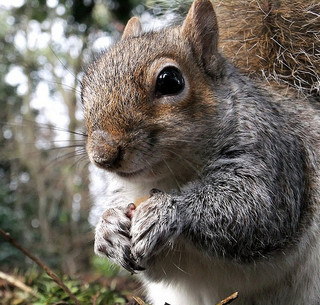Where Do Gray Squirrels Live?
By Chris Williams on July 8, 2014.
 In New Hampshire and Massachusetts, our gray squirrels live and raise their young in nests which are of three different types:
In New Hampshire and Massachusetts, our gray squirrels live and raise their young in nests which are of three different types:
Squirrel leaf nests in trees
Leaf nests are made of dried leaves woven together with humus and twigs, with a single entrance that faces the trunk or nearest branch. They are usually very high up in a tree and are used mostly as temporary summer nests since they are cooler than den nests. You can spot squirrel leaf nests once leaves are off of the trees. From the ground, they look like a somewhat unkempt globular mass of leaves, about 14-16 inches in diameter. Last winter, I stood in my back yard and counted a total of 28 squirrel nests high up in the trees! Of course, they weren’t all active and some may even have been a couple of years old.
Squirrel den nests in tree holes
For a squirrel, a tree hole nest is prime property that is often fought over. A den nest provides better protection from the elements than a leaf nest. Baby squirrels born in den nests have a greater survival rate than babies born in leaf nests. Squirrels often have both summer leaf nests and a den nest which they move into when colder weather arrives. A den nest can be a hole where a branch has fallen off of a tree or an old woodpecker nest hole. It is usually already partly hollowed out and the squirrel periodically must gnaw at the edges of the hole to keep it from healing closed. A den nest is lined with leaves, bark strips, and soft plants.
Both tree leaf nests and den nests are built in trees that are clustered in groups rather than in single standing trees to give greater protection from weather and more escape routes from predators. So if you have a heavily wooded property, you are more likely to have squirrel nests in your trees.
Squirrel nests in attics and other voids in structures
Unfortunately, gray squirrels don’t limit themselves to outdoor nest sites. A shed, or an attic or other inside void space near the roofline of your home makes a very nice, protected nest site (see “Squirrels in the Attic!”). If a squirrel (usually a pregnant female) can find an opening or even a corner joint or a knot hole, she will gnaw to make the opening large enough to get inside. Once inside the attic, she will make a nest of leaves, or chewed up paper or fabric, or she may just tunnel into insulation.
Don’t Seal Squirrel Holes Unless You Know What You’re Doing!
Having squirrels nesting in your home is not a good thing. They can do significant damage by chewing on materials, including wiring. They urinate, defecate, tear up insulation, and hoard food and nest material in the space. Squirrels have parasites like fleas, ticks, and mites that sometimes move into living spaces.
If you end up with squirrels in your attic, you need to contact a professional with experience in removing and excluding nuisance wildlife. It’s very easy to seal squirrels, especially babies, in the attic if you try to close openings. At Colonial, we make sure all squirrels are out of the space before we begin squirrel-proofing your home to keep squirrels out permanently. For more information on how and why we do squirrel exclusion, see “Squirrel-proofing Your Home.”
Photo credit: davidpiano92 / Foter / Creative Commons Attribution-NoDerivs 2.0 Generic (CC BY-ND 2.0)